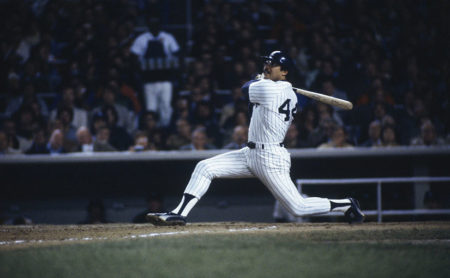Ferocious Uppercuts (Part II): Swinging for the Fences and Big Money
 Part II of a three-part series (See Part I)
Part II of a three-part series (See Part I)
Even though free-agency technically began in 1969 when Curt Flood was traded by the St. Louis Cardinals to the Philadelphia Phillies and refused to report, his defiance eventually led to a Supreme Court case that Flood lost. But his case was the beginning of an arbitration system that heard players union and owner disputes. A few years later, one of those arbitration hearings led to free-agency for Jim ‘Catfish’ Hunter, whose contract was voided and Hunter declared a free agent in December 1974, joining the New York Yankees a few weeks later after signing a five-year, $3.35 million contract.
Andy Messersmith and Dave McNally, who played without contracts in 1975, were declared free-agents after the season.
A year later, the second year of free agency, the top free agents were Reggie Jackson, Bobby Grich, Don Baylor, Sal Bando, Joe Rudi, Rollie Fingers, Dave Cash, Gene Tenace, Don Gullett,and Gary Matthews. Several home-run hitters, some all-around players and excellent pitchers.
Of the group, only Reggie Jackson and Rollie Fingers were elected to the Hall of Fame. Perhaps the most expensive prize of the group was Jackson, who played the 1976 season with the Baltimore Orioles, and then, after the season, signed a lucrative five-year contract with the New York Yankees for $2.96 million.
As the ink dried, the cry of sold was heard throughout baseball. The thud of a gavel ringing in the aeries. Sold. To the New York Yankees and George Steinbrenner.
It was a simple story. Home runs bought for a premium price. Two World Series victories later, it seemed like a damn good deal for everyone involved.
The message was clear: Hit a lot of home runs and you, too, will receive a lucrative free-agent contract—if you’re team allows you to leave.
But if your team doesn’t pony up the big money, the New York Yankees are always on the lookout for another big bat, and it could be your player. And if not the Yankees, the California Angels and other teams lurked with fat wallets bulging with free-agent green. Ready to pounce.
Although over time, more and more teams realized the folly of allowing their best players to leave without recompense. So, players like Reggie Jackson and Rollie Fingers did not hit the marketplace often.
As time elapsed, it became clear many players who received big contracts could not produce under the intense pressure and scrutiny of the dollars flapping in the broadcasting breeze. Just because a player received a big payday didn’t mean he could deliver the big numbers the team thought they were buying.
And as a player failed to meet expectations, he would be defined by his free-agent contract. Adding more pressure to the millions now in his bank account. So, whenever a player came to bat, or took the mound, especially on national telecasts where broadcasters tended to be glib and provocative, the audience was reminded the player had signed a huge contract before the season. The $100 million dollar man was disappointing the team. If only he could live up to the expectations, the team would be … . The truth was only a few players could produce exceptional results under the limelight.
Today, there seems to be a consensus that due to monetary cost, and the wear and tear most players show on their baseball selves by the time they hit free-agency, free-agency is not only not a guaranteed path to championship contention, it must be approached carefully. Reassessed. Since, in today’s baseball, the best players hardly ever reach free-agency.
Because these days, few great players hit free-agency in their baseball prime, meaning most of the players who enter free-agency are years past their best years and trending down (look at Albert Pujols’ numbers before and after the L.A. Angels signed him to a 10-year contract). Many All-Star quality younger players are signed to long-term contracts before they’re eligible for arbitration, or before they hit free-agency after their sixth season. Clubs offer below-market contracts for longer durations. The player receives security, and the club pays much less than if they had signed a free-agent.
So, teams in 2018 wouldn’t’ve rushed to sign free-agents like Josh Hamilton, who signed with the L.A. Angels for five years and $114.3 million dollars prior to the 2013 season. They would think twice about it, peruse their analytics, and then consider Hamilton’s age at the time, even though the season before he had belted 43 home runs for Texas with an OPS of .930 and a WAR of 4.8. in his age 31 season.
They might even remember that L.A. had signed Albert Pujols in his age 32 season to a 10-year, $240 million dollar contract only one year before. And they might have thought that contract a huge mistake.
Some might say the Angels threw caution to the wind, assuming the team was on its way to the World Series based on Hamilton’s .930 OPS the season before, combined with Pujols’ first season marks of 3.3 WAR and .859 OPS.
Perhaps L.A. was dreaming Pujols and Hamilton together could form an explosive offensive combination. Except they weren’t explosive at all. Their first season together in Anaheim, 2013, their metrics were:
Josh Hamilton: 1.3 WAR / .739 OPS
Albert Pujols: 0.5 WAR / .767 OPS
With their two best players costing the team approximately $47 million dollars a season for performance that was only barely better than two Triple A players could offer for $800,000 or $900,000 dollars combined (or so), it’s no wonder the Angels went nowhere that season. Even with the amazing Mike Trout’s 10.1 WAR and .988 OPS that year. And even though Hamilton and Pujols combined for 38 home runs, that was not enough to prevent a 78-84 record and a third place finish in the American League West.
That L.A. jumped at the chance to trade Hamilton back to Texas after the 2015 season surprised no one. The Angels were so eager to rid themselves of Hamilton they agreed to pay almost all of his contract just to trade him, since no other team would trade for him at his excessive price tag.
The Baltimore Orioles are in a similar predicament today with Chris Davis, whose massive $161 million dollar contract (built on 126 home runs walloped over three prior seasons) is untradeable, especially based on Davis’ 2018 numbers: a -2.9 WAR, and an OPS of .550, way below league average. Compare his OPS to that of a good hitting pitcher, Jake Arrieta, who sports a .405 OPS in 2018 for the Philadelphia Phillies. Davis is just barely more productive than Arrieta, despite the few home runs he’s hit this year.
These are but a few examples of bad free-agent signings. Teams reaching for slugging potential (read home-run hitting) based on outstanding slugging numbers when the players were in their primes.
(See Part III)
























